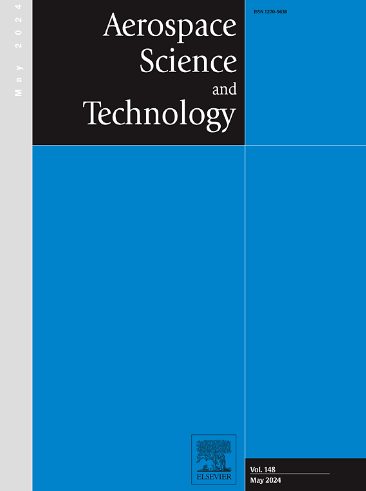Effect of injection location on mixing characteristics with pylon downstream of cavity
IF 5.8
1区 工程技术
Q1 ENGINEERING, AEROSPACE
引用次数: 0
Abstract
Scramjet propulsion holds promise for high-speed travel and reusable satellite launches, but fuel combustion at supersonic speeds presents a challenge. Limited retention time hinders proper air-fuel mixing. While placing a pylon upstream improves mixing, its impact downstream remains unexplored. This study investigates the effects of different fuel injection locations within the cavity on mixing performance. Numerical simulations with the Improved Delayed Detached-Eddy Simulation (IDDES) turbulence model are used to examine various injection locations. The study found that placing the pylon downstream significantly altered flow patterns. This led to the formation of additional vortices and better mixing downstream and within the cavity. The penetration height is also augmented due to the presence of a pylon. Different injection locations varied in mixing efficiency, penetration height, and total pressure loss, with normal-flow injection close to the cavity's aft showing better overall mixing performance. Dynamic Mode Decomposition (DMD) analysis provided insights into mixing improvement mechanisms, highlighting the effect of injection strategies on flow dynamics and relation with pressure spectra. DMD modes showed distinct dominant frequencies for each injection case, influencing lateral mass and momentum exchange within the cavity and affecting shock interactions. The findings underscore the significance of judiciously selecting injection positions, accounting for mixing efficiency, penetration height, and total pressure loss.
注入位置对空腔下游塔架混合特性的影响
Scramjet 推进技术为高速旅行和可重复使用的卫星发射带来了希望,但超音速下的燃料燃烧是一项挑战。有限的滞留时间阻碍了空气与燃料的适当混合。虽然在上游设置塔架可以改善混合效果,但其对下游的影响仍有待探索。本研究调查了空腔内不同燃料喷射位置对混合性能的影响。使用改进的延迟分离-埃迪模拟(IDDES)湍流模型进行数值模拟,以检查不同的喷射位置。研究发现,将塔架置于下游会显著改变流动模式。这导致形成更多的涡流,并改善了下游和空腔内的混合。由于塔架的存在,穿透高度也有所增加。不同的注入位置在混合效率、穿透高度和总压力损失方面各不相同,靠近空腔尾部的常流注入显示出更好的整体混合性能。动态模式分解(DMD)分析深入揭示了混合改进机制,突出了注入策略对流动动力学的影响以及与压力谱的关系。DMD 模式显示了每种注入情况下的不同主导频率,影响了空腔内的横向质量和动量交换,并影响了冲击相互作用。这些发现强调了明智选择注入位置的重要性,同时考虑到了混合效率、穿透高度和总压力损失。
本文章由计算机程序翻译,如有差异,请以英文原文为准。
求助全文
约1分钟内获得全文
求助全文
来源期刊

Aerospace Science and Technology
工程技术-工程:宇航
CiteScore
10.30
自引率
28.60%
发文量
654
审稿时长
54 days
期刊介绍:
Aerospace Science and Technology publishes articles of outstanding scientific quality. Each article is reviewed by two referees. The journal welcomes papers from a wide range of countries. This journal publishes original papers, review articles and short communications related to all fields of aerospace research, fundamental and applied, potential applications of which are clearly related to:
• The design and the manufacture of aircraft, helicopters, missiles, launchers and satellites
• The control of their environment
• The study of various systems they are involved in, as supports or as targets.
Authors are invited to submit papers on new advances in the following topics to aerospace applications:
• Fluid dynamics
• Energetics and propulsion
• Materials and structures
• Flight mechanics
• Navigation, guidance and control
• Acoustics
• Optics
• Electromagnetism and radar
• Signal and image processing
• Information processing
• Data fusion
• Decision aid
• Human behaviour
• Robotics and intelligent systems
• Complex system engineering.
Etc.
 求助内容:
求助内容: 应助结果提醒方式:
应助结果提醒方式:


